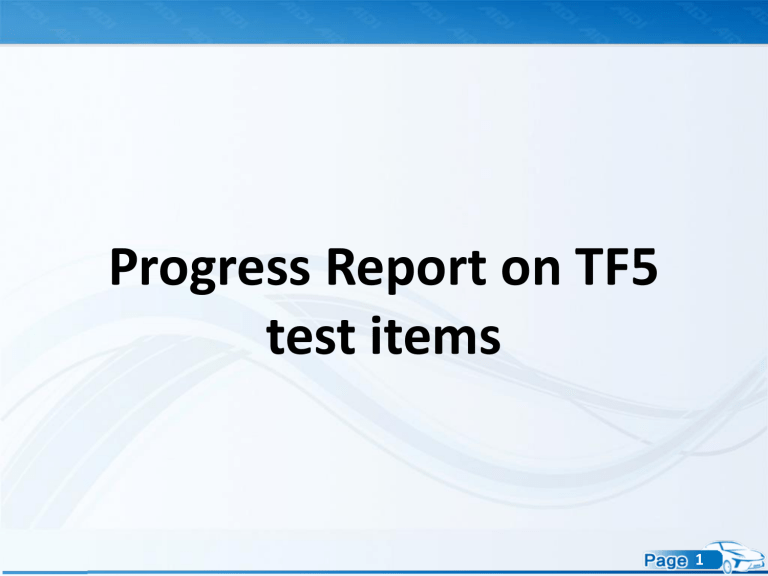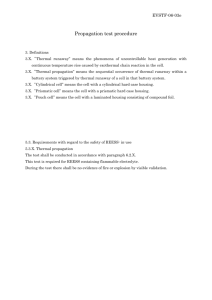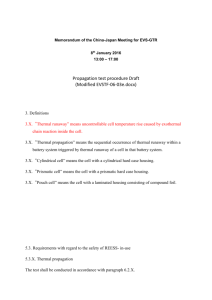progress report

Progress Report on TF5 test items
1
Content
1.Status update on TF5
2.Summary
3. Next step activity
2
Status update on TF5
Cell/module level test procedure proposals and requirements sent for reviewing on Feb. 15 th , 2014;
• Feedback from Korea on Feb. 27 th , 2014;
• Comments from SK, Continental on Dec. 16 th , 2013;
• Feedback of OICA on 20 th Mar., 2014;
• Teleconference held on April 9 th .
3
Status update on TF5
1.
Some participants expressed that the whole vehicle and system design could guarantee the EV safety
2.
TF5 have been carrying on lots of discussion about the needs of tests from the cell/module level
3.
The definition of module was proposed, which is A group of cells connected together either in a series and/or parallel configuration with or without protective devices (e.g. fuse or PTC) and monitoring circuitry, which is able to be transported and replaced.
4.
Cell/module level test items were added on the 4th Bei Jing meeting
4
Summary
1. cell/module are the most important components in the EV power system, some safety risks caused from the characteristics of cell/module itself, especially when a short circuit happens in a module, it may cause the cell venting, burning, or even explosion and lead to propagation.
2. The phenomena of internal short circuit couldn’t be monitored and controlled by BMS, would cause serious safety consequences once it happens. China proposes test items to simulate for internal short circuit and thermal propagation.
5
Next Step Activities
1. About the cell/module level tests, it is not necessary to repeat all the existing system level tests, but to identify the specific test items such as: internal short circuit, thermal propagations
2. Further discussion and research will be carried on about the test items and test procedures.
6
Thanks!
7
Back-ups
8
Nail penetration test
Internal short circuit test
9
Adiabatic Simulation
Meltdown Temperature of separator is the key factor for Thermal Runaway
• T lower than 493K, the internal short circuit is the major cause for the thermal runaway
• T higher than 493K, decomposition of anode and cathode materials are the major cause for thermal runaway
480
460
440
420
419K
3580s
0.0022Ks
-1
400
0 5000
Temperature
Heating rate
461K 24211s 0.04Ks
-1
24348s
0.6
0.5
0.6
0.5
Heating rate
Negative
SEI
Solvent
0.012
Positive
Electrolyte
Gasifying
0.00010
0.0040
0.0035
0.0030
0.4
0.0025
0.4
453K 23311s 0.005Ks
-1
0.008
0.0020
0.3
0.00005
0.3
0.0015
0.2
0.004
0.2
0.1
0.1
0.000
400 420 440
0.0
20000
0.0
25000 10000
Time/s
15000
400 410 420 430 440 450
Temperature/K
Internal short circuit leads to thermal runaway
0.00000
460 470 480
0.0010
0.0005
0.0000
10
Nail penetration test
The current Internal short circuit test method is recommended, such as JIS
8714 of Japan.
11
Nail penetration test
The state of the membrane after nail penetration test: the perforation membrane become thin and transparent, and some membrane melt at the edges of contact with the needle. A small amount of active powder fell off the plate and stuck to the membrane.
Internal short circuit can be simulated excellently by nail penetration test.
12
Nail penetration test before test after test before test Test begin valve open
Temp. reach100℃ Temp. reach 200℃
13
Nail penetration test
Nail penetration test is the more effective alternative test method for the Internal short circuit phenomena.
t=6s t=7s t=8s t=10s t=12s t=20s
14
Oven Test @130 ℃
Oven test is not the normal reliability test item, but the safety abuse test item for thermal stability. Except that considering the application environment temperature, more attention should be paid to the key factors for cell thermal stability itself. And oven test can be used for the simulation of thermal propagation ( for example, if the temp. of one cell increases rapidly at the condition of internal short circuit, this phenomena inserts serious affect on the surrounding cells, thermal propagation will happen).
(UL1642 Environmental Test - Heating Test 、 IEC62660 Reliability and abuse tests - High temperature endurance 、 SAE J2464 Thermal
Abuse Test – Thermal Stability Test)
15
Oven Test @130 ℃
At 130 ℃ , SEI starts to decompose and exothermic reaction begins, thermal runaway will probably happen with the heat accumulation.
And the membrane starts to melt at about 130 ℃ , which leads to higher short circuit risks.
16










